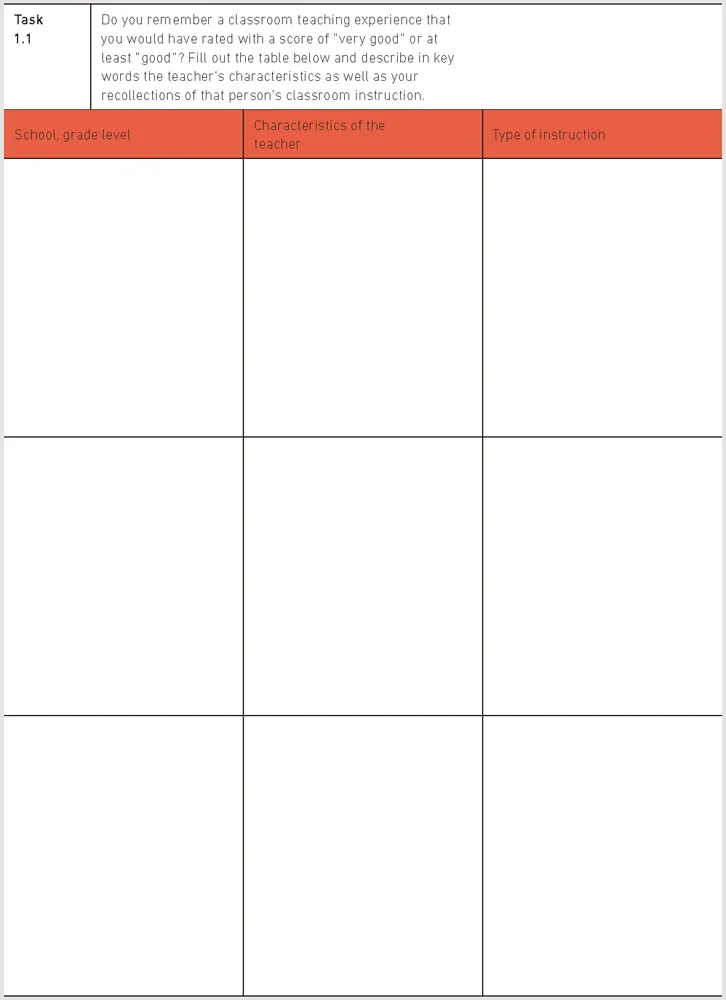
eBook - ePub
Simply good teaching
Hans Berner, Rudolf Isler, Wiltrud Weidinger
This is a test
Buch teilen
- 336 Seiten
- English
- ePUB (handyfreundlich)
- Über iOS und Android verfügbar
eBook - ePub
Simply good teaching
Hans Berner, Rudolf Isler, Wiltrud Weidinger
Angaben zum Buch
Buchvorschau
Inhaltsverzeichnis
Quellenangaben
Über dieses Buch
This e-book contains high-resolution graphics and tables that can only be read on e-readers capable of enlarging images.This combination textbook, workbook, and practice book on general didactics is one of a kind. It brings together contemporary concepts, methods, and reflection, and follows itself the structure of good teaching: from precognition to consolidated knowledge, from application to practice, from practice to reflection. Teachers-to-be and seasoned instructors will find inspiration, practical tips, and theoretical impulses for individual lessons, that meet current standards and remain adaptable to each context."First of all, the present book is simply good." taken from the preface by Andreas and Tuyet Helmke
Häufig gestellte Fragen
Wie kann ich mein Abo kündigen?
Gehe einfach zum Kontobereich in den Einstellungen und klicke auf „Abo kündigen“ – ganz einfach. Nachdem du gekündigt hast, bleibt deine Mitgliedschaft für den verbleibenden Abozeitraum, den du bereits bezahlt hast, aktiv. Mehr Informationen hier.
(Wie) Kann ich Bücher herunterladen?
Derzeit stehen all unsere auf Mobilgeräte reagierenden ePub-Bücher zum Download über die App zur Verfügung. Die meisten unserer PDFs stehen ebenfalls zum Download bereit; wir arbeiten daran, auch die übrigen PDFs zum Download anzubieten, bei denen dies aktuell noch nicht möglich ist. Weitere Informationen hier.
Welcher Unterschied besteht bei den Preisen zwischen den Aboplänen?
Mit beiden Aboplänen erhältst du vollen Zugang zur Bibliothek und allen Funktionen von Perlego. Die einzigen Unterschiede bestehen im Preis und dem Abozeitraum: Mit dem Jahresabo sparst du auf 12 Monate gerechnet im Vergleich zum Monatsabo rund 30 %.
Was ist Perlego?
Wir sind ein Online-Abodienst für Lehrbücher, bei dem du für weniger als den Preis eines einzelnen Buches pro Monat Zugang zu einer ganzen Online-Bibliothek erhältst. Mit über 1 Million Büchern zu über 1.000 verschiedenen Themen haben wir bestimmt alles, was du brauchst! Weitere Informationen hier.
Unterstützt Perlego Text-zu-Sprache?
Achte auf das Symbol zum Vorlesen in deinem nächsten Buch, um zu sehen, ob du es dir auch anhören kannst. Bei diesem Tool wird dir Text laut vorgelesen, wobei der Text beim Vorlesen auch grafisch hervorgehoben wird. Du kannst das Vorlesen jederzeit anhalten, beschleunigen und verlangsamen. Weitere Informationen hier.
Ist Simply good teaching als Online-PDF/ePub verfügbar?
Ja, du hast Zugang zu Simply good teaching von Hans Berner, Rudolf Isler, Wiltrud Weidinger im PDF- und/oder ePub-Format sowie zu anderen beliebten Büchern aus Didattica & Didattica della scienza e della tecnologia. Aus unserem Katalog stehen dir über 1 Million Bücher zur Verfügung.
Information

“To teach a child does
not mean to fill a vessel, it
means to light a fire.”
not mean to fill a vessel, it
means to light a fire.”
Michel de Montaigne (1533–1592)
“Ignorance is the night
of the mind, a night without
moon and stars.”
of the mind, a night without
moon and stars.”
Confucius (551–479 BC)
WHAT IS GOOD TEACHING?
Key characteristics of successful teaching from a teaching research perspective
There are numerous principles which, if observed, demonstrably render teaching more successful and effective. The most important of these are briefly summarized in this chapter with reference to the findings of the renowned teaching researchers John Hattie and Andreas Helmke, as well as the teaching expert Hilbert Meyer. By bringing together in an overall appraisal the teaching principles which Hattie, Helmke, and Meyer consider learning effective, a broad pedagogical consensus is presented, which reflects not only the German-speaking debate but does justice to the international discussion as well.
The fact that the good method of teaching does not exist becomes immediately apparent if one asks a few simple questions: good for what, under what conditions, good for whom, good for when? These questions suggest that good teaching can only be described in a specific context which, in conjunction with a given situation, must constantly be defined anew by the teaching practitioners themselves – taking into consideration the perspectives of all concerned. This perspective should not lead to the misunderstanding that there are no quality characteristics for teaching. “No, there is no such thing as the right teaching method”, says Andreas Helmke, “but there certainly exist instructional quality characteristics which are absolutely and unquestionably valid, there are well-founded standards of teacher behavior, and there are important benchmarks of teacher expertise, about which there is a broad consensus.”1 These characteristics relate to the learning atmosphere on the one hand, and, on the other, to the motivation of the learners but ultimately to the didactic-methodological procedures. Although we address the latter group of characteristics more broadly than the first two, it would not be right to attribute to it a greater significance for successful teaching. Successful teaching is the result of a balanced mixture of an atmosphere conducive to learning, adequate motivation and methodological-didactic know-how.
Most of the twelve characteristics considered will be easily identifiable in the follow-up discussions of the later chapters. For those interested in a more intensive discussion, there are suggestions for further self-study. With a digression to learning objectives and competences, several terms which are important for teacher education are briefly discussed. They should also be part of a general discussion as a link to the teaching methodology.








The following twelve characteristics of good teaching can be grouped into three categories: learning atmosphere, motivation and didactic-methodological know-how. In doing so, we follow a suggestion by Wolfgang Beywl2 who contributed significantly to the reception and understanding of John Hattie in the German-speaking areas by presenting an overview and assessment of the positions developed by the three referenced authors in the introduction of this chapter.
The individual characteristics are primarily taken from the publications Visible learning for teachers by John Hattie3, Unterrichtsqualität und Lehrerprofessionalität (The quality of teaching and teacher professionalism) by Andreas Helmke4 and Was ist guter Unterricht? (What constitutes good teaching?) by Hilbert Meyer5. Each characteristic is thereby referenced with only a few key words which cannot be fully explained in this first chapter and which do not do justice to the nuanced sophistication with which they are presented in the original publications. In spite of the simplified short explanations, the aggregate list of the twelve characteristics provides a good orientation for classroom practice and design. The resultant inferred suggestions nevertheless yield useful instructions and means of action for practical application. A more intensive study from our perspective is meaningful, especially the very broad and particularly relevant themes of successful teaching. Hence the attached bibliographic references with certain characteristics. In our experience, a serious and sustained discussion with teaching practitioners about the characteristics of good teaching has produced extremely positive effects on school management – and with it, occupational satisfaction and the love for the teaching profession as well.
For better orientation, the twelve referenced characteristics of good teaching are listed in the table below and allocated to the superordinate topic areas. Furthermore, the table contains referenced to the comments on learning goals and competences.

Since we strive for the greatest possible transparency in terms of the origin of thoughts, ideas, and findings, we attribute the important contributions of individual authors and findings from Hattie’s meta-analyses in each of the twelve characteristics. However, we reference the authors only when, in our estimation, they can make a specific contribution to a characteristic which justifies their special highlighting.
1 Teaching climate
Helmke and Meyer talk about a climate conducive to learning. By this, they mean that a classroom climate of mutual respect is important, that rules are reliably followed, that all parties assume responsibility, and that a sense of justice and a willingness to help others are shared. The conversational tone must be friendly, the atmosphere characterized by cordiality and warmth, with room for laughter and humor. Moreover, there should be as many learning situations as possible that are not connected to performance assessment, and only as many achievement-oriented situations as necessary (see chapter 8). Concerning the pace of work, a relaxed atmosphere should be created: tolerance for slowness and a reasonable waiting time for student responses are considered important. Hattie equates the characteristics of a learning-conducive climate in the classroom with a high-effect strength in the areas of teacher-student relations, class cohesiveness, and low levels of fear. Hattie particularly emphasizes that an optimal classroom climate is characterized by an atmosphere of trust which tolerates mistakes as part of the learning process.
2 Classroom management
Conducting a class – or more specifically, classroom management – is often considered the most deciding factor of a successful teaching environment, not only by teachers, but also school management and educational authorities. Helmke considers it a necessary precondition for successful and ambitious teaching. Modern classroom management is based on the rules determined by teacher and students. It is imperative to address disruptions preventively with strategies of steering attention (that is, through instructions and organizational measures to control attention). When disruptions occur, they should be addressed discreetly and in a non-dramatic and time-saving fashion. Meyer does not include classroom management among the ten most important characteristics of good teaching, but his demands for clear structuring of teaching, a learning-conducive climate, and meaningful communication, comprise essential elements of classroom management. Efficient classroom management has a high impact on successful learning processes in Hattie’s meta-analysis. Because classroom management is generally considered important, but not always easy, the following example should shed some light on some possibilities for further in-depth study from among the great number of publications about the topic of classroom management: Disruptions in the classroom (Störungen in der Schulklasse) by Hans-Peter Nolting6 which further builds on the learning theory-based classic study by Jacob Kounin7 is a guideline to classroom management which goes far beyond Kounin’s classic study and aims at optimal behavior control and guidance and offers easily applicable and trainable suggestions for classroom management. Discipline and self-discipline in the school (Disziplin und Selbstdisziplin in der Schule) by Jürg Rüedi8 is rather deep psychology-oriented and emphasizes the relationship between teacher and students in classroom management. In our view, it is well worthwhile that not only prospective teachers but all teachers who would like to optimize their classroom management study this publication.
3 Real learning time
That total classroom time should entail the highest possible percentage of real learning is an essential characteristic of good teaching according to Meyer. This can be accomplished through good time management, punctuality, and most of all by deferring questions of an organizational nature outside of the defined, actual teaching time. The proportion of genuine learning time to total classroom time is important for Helmke as well, though he subsumes this point under efficient classroom management. In any case, it is certainly helpful to question how much time is lost in teaching with activities that cannot be attributed to learning.
4 Motivation
For Helmke, a diverse motivation i...